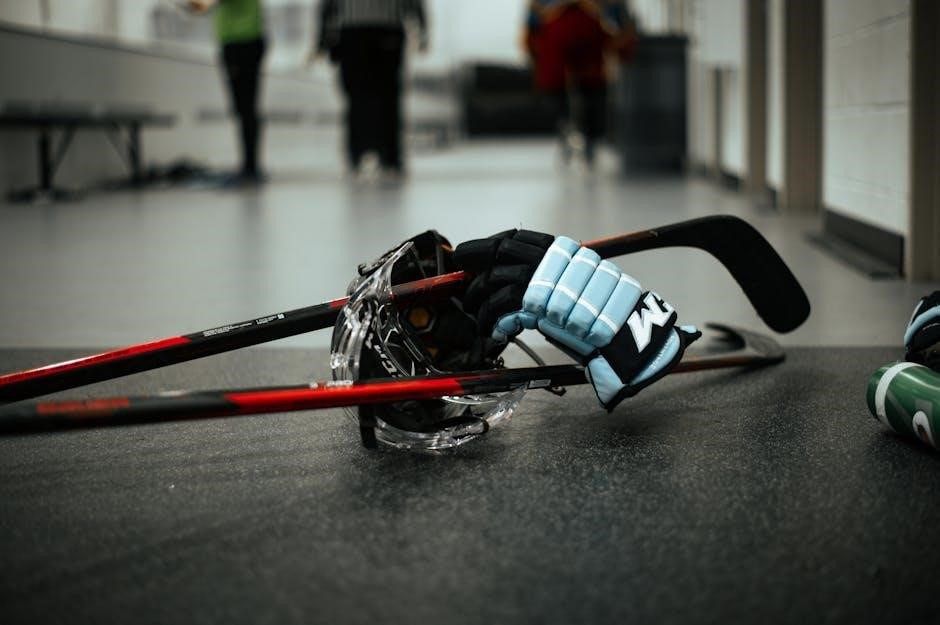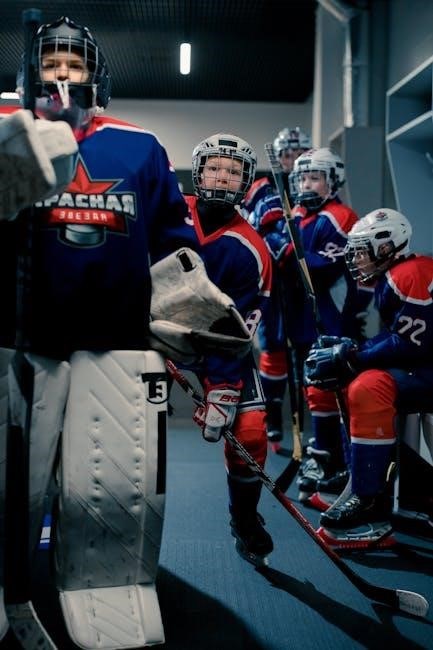Hockey stick sizes are crucial for optimal performance and comfort, varying by height, weight, and playing style. Proper fitting enhances control, shooting, and overall gameplay efficiency.
Understanding Hockey Stick Length
Hockey stick length is measured from the top of the stick to the end of the blade, typically ranging from 36 to 38 inches for adult players.
Height and Chin Measurement Method
The height and chin measurement method involves standing with skates on and holding the stick vertically in front of you. The stick should reach just below or above your chin when upright. For most adult players, this typically results in a stick length of 36 to 38 inches. This method ensures the stick is proportional to your body, allowing for proper handling and mobility. It’s a straightforward technique widely used by players to determine their ideal stick length effectively.
Belly Button to Floor Measurement Alternative
The belly button to floor method is a reliable way to determine hockey stick length. Stand upright, measure from the center of your belly button to the floor. This measurement corresponds to your ideal stick length, ensuring proper handling and balance. It’s a popular alternative to the chin method, offering a consistent and accurate sizing approach. This technique is widely recommended for players of all levels, providing a straightforward way to find the perfect fit for optimal performance on the ice;
Flex and Weight Considerations
Flex and weight are critical for hockey stick performance, affecting handling and shooting. Proper weight distribution enhances control, while flex influences power and accuracy, optimizing gameplay.
Determining Flex Based on Player Weight
Determining the right flex for a hockey stick involves matching the player’s weight to the stick’s flexibility. A common method is to divide the player’s weight (in pounds) by two to estimate the ideal flex rating. For example, a 150-pound player might use a 75-flex stick. Lighter players benefit from softer flex for better control, while heavier players need stiffer flex for power. Proper flex ensures optimal performance, as it directly impacts shooting accuracy and handling. Materials like carbon fiber also influence flex, with higher-end sticks offering precise weight-to-flex ratios. Custom options are available for precise fit.
Impact of Stick Flex on Performance
Stick flex significantly impacts a player’s performance, affecting shooting power, control, and handling. Softer flex sticks are ideal for younger or lighter players, as they allow for easier bending and better control during stickhandling. Stiffer flex sticks, favored by heavier players, generate more power for shots and passes. Incorrect flex can hinder performance, reducing accuracy and efficiency. Players must balance flex with their weight and playing style to optimize their game. Advanced materials like carbon fiber enhance flex consistency, ensuring reliable performance across various playing conditions and techniques.

Curve Patterns and Their Effects
Curve patterns influence puck control, shooting accuracy, and passing precision. Different curves suit various playing styles, with some enhancing wrist shots and others improving slapshot power.
Common Curve Types and Player Preferences
Hockey sticks feature various curve types, each catering to specific playing styles. The most common curves include mid, heel, and toe curves. Mid curves offer balanced puck control and shooting, making them ideal for all-around players. Heel curves provide better control and accuracy, often preferred by playmakers. Toe curves, deeper and more pronounced, enhance wrist shots and slapshots, favored by snipers. Players’ preferences vary, but the right curve can significantly improve performance, enabling better passing, shooting, and puck handling. Understanding these differences helps players choose a stick that aligns with their on-ice role and skills.
Influence of Position and Playing Style
A player’s position and style significantly influence hockey stick size preferences. Forwards often prefer shorter sticks for agility and puck control, while defensemen opt for longer sticks to enhance reach and slapshot power. Playmakers tend to favor sticks with a mid-curve for precise passing and control. Snipers, meanwhile, prefer deeper curves at the toe for powerful and accurate shots. Goaltenders use specialized sticks with larger blades for better puck coverage. Aligning stick size and curve with position and style ensures optimal performance, enabling players to execute their roles effectively on the ice.
Stick Categories by Player Demographics
Hockey sticks are categorized into Senior, Intermediate, Junior, and Youth sizes, differing in length and shaft circumference to suit players of various ages and skill levels.
Senior, Intermediate, Junior, and Youth Sizes
Hockey sticks are categorized into four main size groups: Senior, Intermediate, Junior, and Youth. Senior sticks are the longest and sturdiest, designed for adult players, typically measuring 36.5 to 38 inches. Intermediate sticks are slightly shorter and lighter, catering to teenage players. Junior sticks are shorter still, suitable for younger players, while Youth sticks are the smallest, designed for children. Each category adjusts not only in length but also in shaft circumference, ensuring a better fit for varying hand sizes and strength levels. Proper sizing enhances control, comfort, and performance for players of all ages and skill levels.
Age and Height Correlations
Hockey stick size is closely tied to a player’s height and age. Taller players typically use longer sticks, while shorter players opt for shorter ones. For example, a 36.5-inch stick is common for adults, while youth players may use sticks around 28 inches. Age also plays a role, as younger players require smaller sticks for better control. Current trends show a shift toward longer sticks, up to 38 inches, for added reach and power. Proper sizing ensures optimal performance, so consulting a sizing chart based on height and age is recommended for the best fit;

Material and Weight Impact
Hockey sticks are made from materials like carbon fiber, fiberglass, and wood, each offering unique performance benefits. Lighter sticks enhance handling, while heavier ones provide durability.
Performance Differences in Materials
Hockey sticks are crafted from various materials, each offering distinct performance attributes. Carbon fiber sticks are lightweight, enhancing puck control and shot power, making them ideal for skilled players. Fiberglass sticks are more durable and cost-effective, suited for younger or casual players. Wooden sticks provide a traditional feel but are heavier and less common in modern hockey. Composite sticks, blending materials like carbon and fiberglass, strike a balance between weight, durability, and performance. The choice of material significantly impacts a player’s ability to handle the stick effectively, making it a critical factor in selecting the right hockey stick.
Weight Considerations for Handling
Hockey stick weight significantly impacts handling and performance. Lighter sticks, often made from high-end materials like carbon fiber, enhance stickhandling and shooting speed, benefiting offensive players. Heavier sticks, typically made from fiberglass or wood, provide durability and power, suiting defensive players or those prioritizing strength. The balance between weight and material affects a player’s agility and control on the ice. Proper weight selection ensures optimal performance, with lighter options favoring speed and heavier ones offering stability and endurance during games.

Current Trends in Stick Lengths
Longer hockey sticks, up to 38.5 inches, are gaining popularity in 2025, offering enhanced performance, better reach, and catering to modern player preferences.
Popularity of Longer Sticks
Longer hockey sticks, up to 38.5 inches, are becoming increasingly popular among players. This trend reflects modern preferences for greater reach and puck control. Many professional and amateur players opt for sticks slightly longer than traditional lengths, believing it enhances shooting power and passing accuracy. The shift toward longer sticks also aligns with advancements in stick technology, offering better durability and performance. As a result, manufacturers are now producing more options in the 36.5 to 38.5-inch range to meet growing demand.
Advantages and Drawbacks of Trends
Longer hockey sticks, up to 38.5 inches, offer increased reach and puck control, appealing to many players. They enhance shooting power and passing accuracy, especially for taller athletes. However, these sticks may be heavier and less maneuverable, potentially hindering stickhandling for smaller or younger players. The trend toward longer sticks reflects evolving preferences but may not suit all body types or playing styles. Balancing performance benefits with personal comfort is key when adopting this trend.

Purchasing Options and Recommendations
Buy sticks from trusted retailers or online stores, considering custom options for precise fit. Prioritize flex, length, and material based on your playing style and needs.
Where to Buy and Custom Options
Hockey sticks are available at specialty sports stores, online retailers like Amazon or HockeyMonkey, and directly from brands such as Grays Hockey or Bauer Vapor. Custom options allow players to tailor sticks to their exact preferences, including length, flex, and curve pattern. Some brands, like Ronin, offer bespoke sticks made to specific measurements. Online retailers often provide sizing guides and customer reviews to aid in selection. Purchasing from trusted sources ensures authenticity and quality, while custom options enhance performance for unique playing styles and preferences.
Expert Opinions and Brand Suggestions
Experts recommend selecting hockey sticks based on playing style, not just position. Trusted brands like Grays Hockey and Bauer Vapor are popular for their performance and durability. Grays Hockey is favored by professionals, while Bauer Vapor offers high-quality options for various skill levels. Custom sticks, such as those from Ronin, cater to specific needs. Experts suggest considering materials like carbon fiber for lightweight feel or fiberglass for durability. Consulting with a fitter or using brand sizing guides ensures the best fit. Prioritize brands known for innovation and quality to enhance performance and longevity.